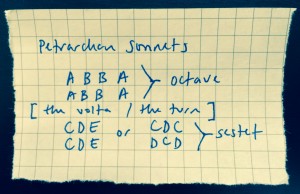I have been reading Mary Oliver’s Rules for the Dance; I must say, I may not have appreciated it as much before, but how wonderful is the land of metrical poetry. I think the rules and boundary lines are particularly important in our post-post modern world of make-your-own-rules and free verse, and what have you.
There are so many thick metaphors here, and I would like to explore it all.
My exploration of God’s character has shown me time and again that boundary lines — creating or respecting intentional borders — bring freedom and the space to play. On so many levels, this is admittedly contrary to what our culture tells us, to be honest. I’m excited to explore some limits in poetry to see what I can find. I’m starting to believe that metrical poems can be as playful as a carnival ride.
Do you know how excellent Petrarchan / Italian sonnets truly are? You probably memorized at least one Shakespearean sonnet in high school (if you were so lucky). Shakespearean sonnets were a resuscitation of an old form, a sonnet renaissance of sorts – and a means to make the Italian sonnet form easier to appropriate into a less musical English.
Well, I will be tinkering with these puppies in the days to come. For now, as far as Petrarchan sonnets go, here are the basic rules — the iambic pentameter goes without saying —
For further reading: Poemshape brilliantly breaks down the difference between Shakespearean, Spenserian, and Petrarchan sonnets.
[Sprocket by slimmer_jimmer]

